|
TRANSLATE THIS ARTICLE
Integral World: Exploring Theories of Everything
An independent forum for a critical discussion of the integral philosophy of Ken Wilber
 Brad Reynolds did graduate work at the California Institute of Integral Studies (CIIS) before leaving to study under Ken Wilber for a decade, and published two books reviewing Wilber's work: Embracing Reality: The Integral Vision of Ken Wilber (Tarcher, 2004), Where's Wilber At?: Ken Wilber's Integral Vision in the New Millennium (Paragon House, 2006) and God's Great Tradition of Global Wisdom: Guru Yoga-Satsang in the Integral Age (Bright Alliance, 2021). Visit: http://integralartandstudies.com Brad Reynolds did graduate work at the California Institute of Integral Studies (CIIS) before leaving to study under Ken Wilber for a decade, and published two books reviewing Wilber's work: Embracing Reality: The Integral Vision of Ken Wilber (Tarcher, 2004), Where's Wilber At?: Ken Wilber's Integral Vision in the New Millennium (Paragon House, 2006) and God's Great Tradition of Global Wisdom: Guru Yoga-Satsang in the Integral Age (Bright Alliance, 2021). Visit: http://integralartandstudies.com
Crazy Wisdom Is Not CrazySpiritual Choices, Part 4Brad Reynolds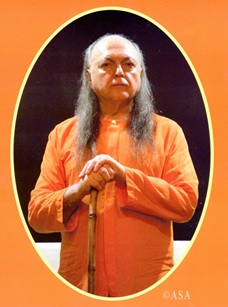 W ith a genuine Enlightened human being, whether male or female, one of the principal characteristics about them is their unbounded freedom from social constraints (via ego-transcendence) along with spontaneous acts of instruction and love. Since it's usually obvious to those close by that the Guru's actions arise from a deep well of insight and clarity, then it's evident the Guru is not (nor ever was) expressing crass egoic desires or inflated self-worth but rather sincere love and care for others. Deciding this may be a fine line of judgment, indeed, so unless someone was present during the occasions in question it would be hard to say what was actually occurring between the Guru and their devotee(s). Even then, if present, real understanding and insight is required. This certainly seems to be the case with Adi Da Samraj, especially when more closely examining the evidence within the entire spectrum of consciousness, not just from the view of certain social morals and mores, which should all be taken into account (if that's even possible). Most important, the Adept's Spirit-Transmission (Hridaya Shaktipat) is the most critical factor that must be integrated into our understanding of Adi Da and his function as a Siddha-Guru serving other human beings [see Part 2]. Adi Da's foremost critics, however, believe he was acting egoically and thus unethically. Some have apparently made a “career” out of condemning Adi Da Samraj by standing outside looking in (especially on their distorted websites). Their anger (and fear) is palpable. Therefore, I suggest we must take these critics' egoic disposition and motivations into account as well (even if they think they're doing a community service). Again, review the testimonies, especially from his devotees (and even sexual partners)—who are now publishing leelas (or their accounts of Adi Da's divine play) as well as being interviewed—to better understand what was happening. What was going on was spiritual communion as it is with any true Tantric Master, whether in the bedroom or in the temple.[1] In regard to Adi Da's sexuality [see Part 3], it is crucial to accept the fact that many women simply wanted to be with him and sought his attention, which he usually refused, but sometimes invited (or even encouraged). In every case, bar none, the genuine Guru-devotee relationship was always maintained so no one was maliciously abused, although feelings were hurt at times and egos became confused. Overall, however, the gift was love and ecstasy, yet not in the way the conventional mind would necessarily accept. That's what Gurus do: it's their job. If received correctly, lessons are learned and love is revealed to serve one's spiritual development. It's extremely important to realize that the entire Guru-devotee relationship is predicated on the disposition of the transcendence of the ego; thus, all participants have agreed upon these sacred arrangements from the beginning. Consequently, this unconventional play around the Guru was not ego power-tripping by Adi Da, even if some characterize it that way… but it truly wasn't (as a deeper dive into the evidence will reveal). Yes, at times, Adi Da shattered people's expectations, but anyone was free to leave at any time. Some did, even after receiving precious spiritual gifts and understandings often because the familiarity of conventional living is too great for many people to release (or to integrate into their sadhana). This is a fact critics choose to forget and prefer to distort, focusing only on what they misunderstand, and thus attack Adi Da's integrity. But Adi Da was not egoic, nor abusive, nor “crazy.” He was transcendentally wise… and God-Realized. I'm aware the critics disagree harshly with this view, but their perspectives are incomplete expressing a limited point of view. In truth, the so-called “Crazy-Wise” behavior attributed to Adi Da took place mainly during the early years of the 1970s when the Guru was known as “Bubba” (a Southern nickname for “brother”). This was when he more sexually active and challenging—a time when most of the alleged “notorious” stories originate—as he more directly engaged his growing community and challenged them to transcend their egoic preferences. Remember, too, the shaktipat and yogic energy was ablaze in Adi Da's community (in an unprecedented manner)—lighting people up psychically in all manner of ecstatic revelry. These were no mere drunken orgies, as critics like to maintain. They were spiritually-infused events. Yet, admittedly, Adi Da was always free to challenge his devotees and “push their buttons,” so to speak, during all of the decades of his Dharma demonstrations. This is the Guru's business. 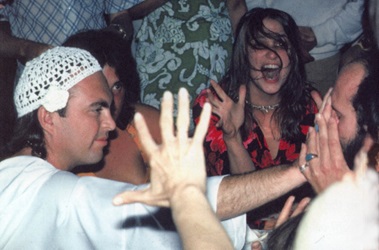
Transmitting Shaktipat by Touch The Mountain of Attention Sanctuary, California, March 1974
Besides, the whole point of the “parties” or celebratory occasions with “accessories,” such as alcohol, beer, and cigarettes (drugs were never handed out[2]), was to demonstrate the limitation of experiences, even yogic-initiated ones (such as with kundalini stimulation). Adi Da, like most Mystics, discouraged the fascination with experiences, high or low, even going so far to call them all “garbage,” for they must be thrown away (or transcended) if genuine Enlightenment is to take place. The only truth that really matters, the only truth that truly frees the heart, is God-Realization and Divine Enlightenment. All experiential phenomena of the separate self, no matter how miraculous or blissful, is to be radically understood and transcended. This was the message, for example, of Adi Da's third book, Garbage and the Goddess (1974), which explained on the back cover:
My Teaching Work over the last two and one half years has been associated with inner and outer miracles, but it was all a way to demonstrate how the fulfillment of experiential life in individuals does not amount in any sense whatsoever to Illumination. The arising of miraculous or extraordinary experiential phenomena does not produce the enlightened man or woman, the wise man. Enlightenment or radical understanding depends entirely on the conscious process, not the experiential one.
Again, the parties and play around the Adept always gave way to Right Life disciplines, including by the Guru himself (who could spontaneously shift from one to the other with no effort). On most occasions, once the play was over, the desire to party with the Guru was itself found to be egoically motivated on the devotee's part. Once the celebratory gatherings ended or subsided, people returned to serving in Satsang and cultivating a deeper spiritual relationship with their Heart-Master as Siddha-Guru, which was always his real demand and instruction. Additionally, never forget that the most brilliant Dharma Talks were being freely given as well, so everything was being explained within the context of Satsang given from the first day to the end of Bhagavan Adi Da's life. Besides, to state the obvious: Adi Da is no longer alive in the body, so now only a spiritual relationship is possible with this Siddha-Guru as Avatar in order for people to be initiated by His Spiritual Heart-Transmission and Divine Presence. This type of spiritual relationship is indeed very personal, but certainly can no longer be sexual (except, perhaps, in dreams or subtle visions). Nonetheless, the “Murti” (or photographic or representation) of his bodily human form is now an agency transparent to the Adept's Spirit-Transmission and Enlightened State. 
From the more conventional (and traditional) perspective, Adi Da also raised and provided for a loving family. He was the father of three daughters (and responsible for a fourth), yet still, he gave them a choice to choose their own life outside of Adidam and his retreat sanctuaries (which most have done), as any good parent should. Indeed, his daughters were given the best schooling in a devotional setting, on all levels, with all of them becoming accomplished artists or musicians, one earning a doctorate, another becoming an actor, among other empowered skills and talents. Their beauty, inside and out, is evident and well-served. The exaggerations and unjust complaints of Adi Da's sexual extremes needs to be released and placed in proper context. At worst, they were fleeting and not what he was truly about (as critics fail to recognize). Critics make him out to be a selfish madman, overlooking his tender, loving nature and the endless gifts he gave his devotees. Let me allow his youngest daughter to speak:
It always struck me how Beloved Bhagavan [my father] was completely conscious in every moment. There was never a moment when He was dull, or complacent, or not present. Anything that came into His field of awareness was given His absolute one-pointed attention and regard. He did not hold back from anything. He was as curious as a child, as wide-eyed as one newly in love with everything that appeared before Him. I marveled at His absolute non-avoidance of relationship. He lived the Heart down to His toes. He did not hold back in His Heart from anyone or anything, despite apparent disappointments, betrayals, or disturbances. He was a warrior of Love, down to the last moment of His physical life…. His Life was never for Himself. He gave His Life entirely to serving His devotees, and all of humankind, through His fullest Submission and Consideration of all human life.… Every time I arrived, and every time I said goodnight to Him, He would give me a hug, and kiss me, and tell me He loved me. We would blow each other a kiss and He would wave to me as we parted. He never once forgot to do this, a gesture of His love that is burned in my heart forever.[3]
If a person listens attentively, it's easy to realize Heart-Master Adi Da intimately and lovingly taught and served everyone near him with his enlightened insight and radiant transmission, including his intimate circle of lovers. Yet, he was always very demanding about their sadhana (disciplined practice) and how they relate to him as their Siddha-Guru, their Heart-Master, to fulfill his function as guru, leading them from darkness to light. He has done so in precisely the way any Awakened Adept-Realizer would do—study the Great Tradition of Adepts—for Adi Da acted with love yet without indulging in the usual “ownership” or marriage games that ordinary people play or by catering to anyone's emotional-sexual baggage and unenlightened desires. In that sense, he was relentless (even heroic), for this man was (and is) an authentic Avataric Siddha-Guru, a Tantric Adept of an ultimate degree. Without a doubt, he did transform people's consciousness and open their hearts to the Truth and Reality of God.
Overall, the gift was love and ecstasy, yet not in the way the conventional mind would necessarily accept. That's what Gurus do: it's their job. If received correctly, lessons are learned and love is revealed to serve one's spiritual development.
The Strange Reaction of Ken Wilber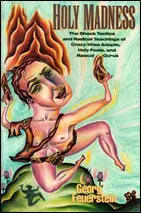
I n the late 1990s, Ken Wilber went on to critique Adi Da Samraj—following the lead of Georg Feuerstein in Holy Madness (1991)[4]—as promoting an archaic form of spiritual practice arising out of the agrarian era of human civilization. Therefore, the pandit has claimed this approach of Guru Yoga-Satsang is no longer adequate for a population grounded in modern democratic principles and an egalitarian society with a more highly-developed sense of individuality. As Feuerstein summarized:
The traditional guru type, I submit, is generally too autocratic and paternalistic for our modern sensibilities. Hence the Eastern-style guru-centric approaches are bound to fail in the West, obliging us to look at alternatives…. At the same time, I feel they are relics of an archaic spirituality that, sooner or later, will be replaced by a more integrated approach to self-transcendence.[5]
Guru Yoga, according to these pandits (not Gurus), is difficult enough, even during premodern times, let alone in a modern world of democracy and human rights (including championing the equal rights of women). Yet, as a scholar of religion, Wilber should have more emphatically emphasized that an esoteric (or inner-oriented) form of a master-devotee relationship is valid (and authentic) and has been practiced for thousands of years by the world's wisest and most sincere individuals.[6] For example, the Tibetan Buddhist tradition of the 84 Maha-Siddhas (“Great Gurus”) places Adi Da's actions entirely within the acceptable range of Enlightened behavior.[7] However, Westerners simply don't know; they expect every “religious person” to be somewhat like, say, Saint Francis (who was at times quite shocking in his behavior) or as Mother Teresa providing charitable care for the poor (which is indeed a noble service). Or they want the comfort given by conventional pastors, priests, ministers, and televangelists, or those who preach sermons that reinforce egoic behavior, not issue demands for ego-transcendence like real Gurus do. 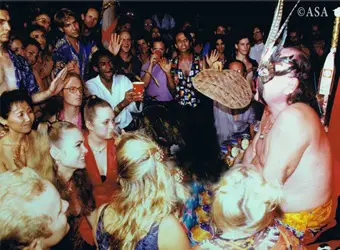
Adi Da Samraj with devotees, New Years Eve 1997-1998
Siddha-Gurus are undoubtedly different. The sacred process of Satsang that involves a living relationship with a Guru is based on meditative transmission (and a feeling presence) engaged within the embrace of genuine compassion supported by real wisdom and love. Yet, sometimes, also with wild abandon and “Holy Madness” or “Divine Madness”—or “wisdom gone wild” (as the Tibetan term explains it). In India, they are sometimes called an “Avadhoot”—or avadhuta meaning one who has “shaken off” worldly concerns—thus such a Siddha is sometimes spontaneously moved to use that wild teaching method in certain situations. The concept as used today seems to have originated with the Tibetan term drubnyon, defined by one scholar as a philosophy that “traditionally combines exceptional insight and impressive magical power with a flamboyant disregard for conventional behavior.”[8] In Tibetan Buddhism, there are the nyönpa (Wylie: smyon pa), or “crazy yogis” and “mad lamas” of Tantra Yoga, where a siddha is an archetypal figure in that tradition (but I will not explore that history here).[9]

Consequently, I believe that Wilber did not get a clear enough or full picture of what Adi Da Samraj was really doing and how his “Crazy Wisdom” behavior was serving his closest devotees in their awakening to God and the practice of love. Without a doubt, Adept Adi Da was always spontaneous, acting like a free Avadhoot, sometimes dancing and singing, occasionally silent and renounced, sometimes critical, at all times, totally loving. The Dawn Horse Press (Adi Da's publishing house) would publish books highlighting the Avatar's latest leelas (or stories), talks and transmissions, hidden from no one, lovingly expressed and fully honored.[10] One book, for example, openly claimed: God Is Not A Gentleman and I Am That One: Ecstatic Talks On Conventional Foolishness Versus the Crazy Wisdom of God-Realization (1983) or a book of poems titled Crazy Da Must Sing: Inclined to His Weaker Side (1982). People knew what they were getting into, or should have; it wasn't hidden (though some of the details were). Essentially, however, it was the Divine Siddhi and authentic spiritual life awakened in Adi Da's Company that people appreciated the most: nothing crazy about that. THIS is what Adi Da was about, regardless of what some disappointed critics maintain. 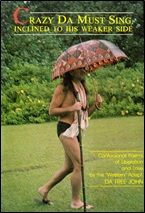
In fact, I was working-writing with Wilber when he went through distancing himself from Adi Da in the 1990s (by posting two critical letters on the Internet and withdrawing his endorsement for publication), acting as if he was the superior Realizer. I encouraged the pandit, during the late '90s, to go sit at the Avatar's feet once again in Darshan (since his first occasion was in 1986) to be reminded Who Adi Da really is: a Transparent Agent to Real God. Ken refused; he sent his wife (his third wife, Marci), a young vivacious woman with no profound understanding of (or experience with) transcendental samadhis and Satsang. She reported back to her husband what he wanted to hear, but he would not go see for himself. Yet, Wilber talked out of both sides of his mouth. One, making public his distaste for Guru Yoga and warning other people about the “dangers” of Adi Da. Yet, two, in private he praised Adi Da claiming the Guru's Transmission was like nobody else's. People were confused—since many held Wilber out to be some kind of “guru” himself (more than just a “pandit”)—so they simply avoided relationship with Avatar Adi Da Love-Ananda altogether. Indeed, “avoiding relationship?”—the inquiry offered by Adi Da to identify the egoic contraction or pattern (of lovelessness)—is pretty much how I would summarize how Wilber treated a lot of people, unless he had a use for them. Adi Da, on the other hand, offers only relationship, a sacred (and most personal) relationship grounded in the Love of God potentially revealing your own Divine Condition to you, an intimacy without bounds. No pandit can do that. Only a genuine Guru can.
Crazy Wisdom Adepts: God's Tricksters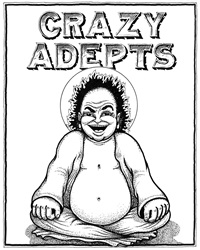 E ven so, Adi Da's “Crazy-Wise” manner was never his principal mode of instruction. Looking at his history during his lifetime—as you can with any fabled career (such as with Ken Wilber, for instance)—it is possible to notice certain phases. Adi Da's “Crazy-Wise Work” was a way of submitting himself to ordinary people (in the early years) who needed to be transformed in the deep levels of the psyche (both culturally and individually). In our times, this was particularly evident at the emotional-sexual level since Westerners tend to suppress the body instead of living from the experience of Absolute Bliss expressing the inherent Happiness of Life. Such an unconventional method, therefore, is an option available to Adepts, as the historical record proves. In Adi Da's case, such “Crazy Wisdom” arose spontaneously, not as an act of egoic strategy. It served its purpose, failed in certain respects, but it was never the main point or essence of what was being taught. That was “Divine Communion”—surrender of self into God-Awareness from the Heart (and through Guru devotion)—an expression of always already present Happiness. This is what turned on Ken Wilber (at one time) and countless other people, whether the public or as devotees. But after his “Divine Emergence Event” in January 1986 (perhaps somewhat fueled by the public crisis of 1985), Adi Da shifted from the “Teaching-Submission Years” to the “Blessing-Revelation Years” dedicated mostly to his Transmission-Blessing done principally in Seclusion (mostly on the Fijian island of Naitauba [see below]). By the mid-1990s—as he took on the name “Adi Da Samraj”— he revealed, “that way of working has come to an end after a quarter century…. [Now] I function in the Ati-ashrami [or renunciate-hermitage] Blessing manner, but not otherwise in the 'Crazy Wise' Submission manner, as in the past.”[11] It must always be understood that this Siddha-Guru was almost always focused on working with advanced practitioners—they were his “coins”[12] for establishing The Reality-Way of Adidam Ruchiradam for future generations. It was then (and is now) left to the Avatar's devotees to be responsible for Adi Da's missionary work in the world. In 1998, the Great Guru further explained:
Access to Me has always been based on practice, and I have Worked with people based on their response to Me. I have never done public work. At most, I have done contact work with those who can be a contact for My Blessing. In other words, I do not have any social relations. Nor do I play the organization man. I don't even normally have conversations with people. My Work for the entire world is My Divine Blessing [Transmission] Work, which I principally do in Seclusion. But sometimes I wander about the world and have contact with all kinds of people through spontaneous association. Thus, I do not live a merely secluded life shut off from the world and its realities. But, now and forever, access to Me is based on people's heart recognition of Me and heart response to Me based on the signs of their practice.[13] 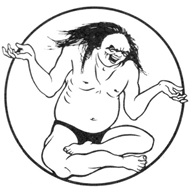
The phrase “Crazy Wisdom” was popularized in the West by the Buddhist Master Chögyam Trungpa (1940-1987), a Tibetan Vajrayana Rinpoche (of the Kagyu and Nyingma lineages), who later published a book (posthumously) with that title in 1991 from seminars given in 1972.[14] As yoga scholar Georg Feuerstein points out, “the expression is an oxymoron, composed of two concepts that on first glance appear to be mutually exclusive. How can wisdom be crazy?”[15] Here, however, we don't mean clinically insane but “flamboyantly unconventional.” During the 1970s, Adi Da's community also used this title on an in-house publication titled Crazy Wisdom, plus, there was a public magazine titled The Laughing Man (represented by an icon of a wild Adept with crazy hair posing in an exaggerated gesture) that would often feature articles explaining this form of “Divine Madness.” Hence people were not left in the dark or fooled, as critics suggest. Yet, mostly, it was (and is) the wisdom that counts, the revelatory nature of Divine existence. This is what attracted the inquiring student, not the “craziness.” Unconventional behavior is sometimes used to pull the rug out from the egoic perspective. Seen correctly, however, it is a play full of Humor and Freedom. The vast majority of the time, however, Adi Da did not act this way; let's be honest. His wisdom far exceeds any “craziness” or “madness” (or unconventional freedom); let's be realistic. It's fully based on real Wisdom and Truth (beyond all conventional thinking). Also known as theia mania (Greek), this unconventional teaching method refers to outrageous, unexpected, and unpredictable behavior designed to shock the ordinary ego out of its everyday conceptions, including the usual idea about how a Saint or Spiritual Master must act. Historian of religions Mircea Eliade also linked it to ancient Shamanism, with their “tricksters” and “shape-shifters,” thus this function holds a revered place in all of the world's major religions, even if not commonly known. Once the radical Adepts of the 1970s, such as Trungpa and Adi Da appeared on the scene, following the counter-cultural revolution of the Sixties, this method began to be criticized as being nothing but an excuse to indulge in unethical behavior. Such actions were often too confusing for many approaching students since these Masters didn't act like the typical Western vision of a renunciate saint or a quiet monk cloistered away praying to God. Their Happiness was uncaused and radiant like the sun, so some got burnt on their way to a greater healing (if used rightly). When performed by an authentic Adept, a person must look deeper and beyond the ego to see if there is true wisdom (and compassion) behind such techniques of instruction. This could include anything from smoking cigarettes to drinking alcohol (and doing drugs), to having sex, yelling, even hitting, and other unconventional, and often questionable, actions enacted to shake the ego out of its normalized complicacy. Trungpa, it must be noted, seemed to be even wilder than Adi Da ever was (so don't confuse them). In reality, this approach is a time-honored sacred tradition, with many instances of authentic practitioners, from East and West. Nonetheless, admittedly, such “crazy wisdom” can be at times hard to accept, no matter what. Only Divine Revelation, in the end, squares such “craziness” (or unwonted behavior) with true wisdom. As Adi Da once commented about the Avadhoot manner of working:
True Wisdom is the capacity for perfect madness. Therefore, only the practice of love has the capacity to keep the Wise sane. And only they can love who have been set free of every humorless intent by the intuition of Infinite Life.[16]
In the historical record, for example, we find the Greek Cynic philosopher and ascetic-eccentric Diogenes (whom Alexander the Great sought out for wisdom only to be insulted) to the Christian “fools for Christ” to the “mad mullahs” and “crazy priests of Allah,” to the famous Tibetan “Divine Madman” Drukpa Kunley (1455-1529) to the “Avadhoots” of Hinduism, to many other eccentric characters in religious history. Thus, we must be careful not to condemn this approach outright but rather must cautiously discern the authentic from the distorted. The other actions of the Adept, seen within the entire context of a Guru's life, must also be taken into account, such as their Teachings on God or our Divine Reality (and Buddha-Nature). We must be willing to recognize their overall demeanor, including their acts of love and care in other circumstances, not just the “crazy” nonconventional outbursts, to see who they really are and what they are really doing. Seeing Adept-Gurus for Who They Are (Not Who We Want or Fear Them To Be)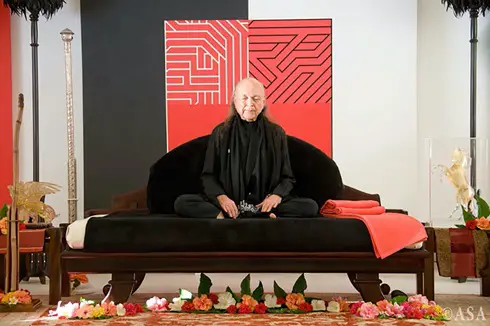 E nlightened Teachings and Masters must be approached with discrimination in order to recognize the genuine from the false, the holy from the crazy, the enlightened from the egoic. The integral metric I presented in Part 1, as found in Dick Anthony's and Ken Wilber's book Spiritual Choices (1987), provides a helpful map and methodology for this critical assignment.[17] Granted, not an easy task, which is why the extreme method of Crazy Wisdom is currently frowned upon (and discouraged) as being an effective and valid Teaching method. Certainly, this is a reason why most teachers should not do it (since they're less than fully Enlightened). But in our embrace of true wisdom, which needs to transcend the egoic madness of the common world, we must be generous enough to see what is really happening with genuine Gurus and not simply base our judgments on our initial reactions. Otherwise, we are the “crazy” ones to dismiss the authentic Adept who just happens to violate society's current standards of what is acceptable and what is not. One must look deeper, below the surface, to see more profound and divine truths. Nonetheless, today the sad state of corruption exhibited by some “Gurus” (as advertised) in our modern global culture has created a distaste for their services. Simply put, some bad apples have ruined (or rotted) the entire barrel. When a Guru, even one sanctioned by a respected tradition, abuses their authority, then they must be called out and dismissed (or disciplined). This “secular enlightenment” is a distraction from authentic Divine Enlightenment. Yet, at the same time, we must make sure that the complaints are genuine and warranted, and not just egoic reactions to their unorthodox (yet possibly Enlightened) behavior. This requires that we understand, and place in proper context, the sacred function of “Crazy Wisdom” since some Adepts do seem to act “crazy” to upend our egoic behavior patterns and attachments to conditional existence. Such “Holy Madness” is still a valid, if at times eccentric, approach to spirituality that directly serves the student's Awakening to Real God, our True Self.[18] History confirms this perspective. Modern people, therefore, should learn by properly integrating this radical wisdom into their current non-traditional (or post-modern) worldview. Nevertheless, such permission gives this instructive behavior no license for egoic abuse or disrespect between Guru and devotee. This is why it takes a keen eye of intelligence and understanding, coupled with an open heart, supported by the laws (and rights) of the larger society, to be able to determine legitimacy and authenticity from falsehood and deception, to distinguish the clan-cult totem-master from the real Spiritual Master. Ultimately, it's the revelation of Divine Truth—the Heart—that has the final say. It would be wise for us, therefore, to learn that the “job” of a Guru is to disrupt the egoic behavior patterns of the approaching student and devotee, which is why discipline (or sadhana) is required. For most undisciplined (or lazy) and conventional people, the disciplines of sadhana (e.g., right diet, regular exercise and yoga, devotional prayer and study, hours of meditation, etc.) are an outright offense from the start. Yet, such practices are not some distorted control issues but one where Guru Yoga-Satsang prepares us for Divine Awakening and to encourage our higher developmental potentials (beyond temporary peak or higher state experiences). When approached correctly, this sacred process is thoroughly grounded in genuine mortality and benign ethics, going beyond the style of any particular teacher or authority, good or bad. Thus, we can't simply use conventional moral standards to understand what is truly happening with genuine Gurus, though immorality (or unloving abuse) is not to be tolerated either. There is a real danger of throwing the baby out with the bathwater, so to speak, if we dismiss all Gurus because of the bad behavior of a few. Our wisest ancestor knew better, and so should we. Overall, Adi Da always insisted on loving relations in his cooperative community, based on a radical understanding of the egoic contraction (or the “avoidance of relationship”), by practicing love and compassion for all living beings (including the non-human and biological world of Nature). His instruction on these matters is arguably unparalleled in world history, that is, if a person openly investigates for themselves—and then practice what he preaches. Adi Da is no charlatan! He is the Real Thing. Remember, as mentioned, the Guru-devotee relationship is predicated upon ego-transcendence, so pushing the limits and boundaries of the self comes with the territory. Nonetheless, it's also based on mutual consent. This relationship isn't simply a game played between egos (for the Guru is essentially egoless), but one of ego-transcending love of God. Only a mature ego can take full advantage of this transpersonal dynamic and use it to transform and evolve their consciousness and not simply project unconscious fantasies and fears onto real Gurus and Enlightened Spiritual Masters. It is our responsibility, therefore, to recognize the true from the fake and then dedicate ourselves to the True and the Real. 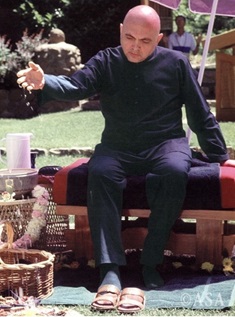
Adi Da Samraj The Mountain of Attention Sanctuary, California, 1988
Truly, in order to see God as the Guru, or the Guru as an agent of God's Grace, you must also be willing to let the Guru be human. In other words, no true devotee claims their Guru to be totally infallible, without human fault, yet they also realize these are minor quirks when compared to the overall validity of what the Guru offers. Gurus get ill; even the Buddha died of food poisoning; Ramana of cancer; Adi Da had glaucoma, etc.; and they don't know every little thing about the relative world (or science). As Wilber once quipped: “I have yet to see a guru run a four-minute mile with his 'perfect body' or explain Einstein's special theory of relativity with his 'perfect mind'.”[19] Yet, so what? They know about Ultimate Truth like no one else we can turn to, so we must learn to use and honor our authentic Spiritual Masters and genuine Gurus. Perhaps, we need to look at ourselves too and stop expecting a Guru-Adept to be infallible, or a “Perfect Master” expecting nothing but blind devotion, but rather cultivate a sacred relationship based on actual Divine Communion and intellectual integrity, where “obedience” is a form of free discipline, which is definitely possible as well. This truth has been proven time and time again, so when looked at rightly and set within the whole picture, any authentic (and transformative) assessment of Guru Yoga needs to take these facts into account. True “Crazy” Wisdom, in other words, is not crazy or mad, nor insane, but is a teaching method delivered with the best of intentions. What is crazy is when, from our conventional perspective, we fail to understand this fact (and reality) and then condemn “Gurus” as being fake and false, thus overlooking their actual function as exemplars of the Divine Truth existing behind (and beyond) the madness of our warring world and the corruption of egoic society as a whole. Only Enlightenment, divine love awakened in the heart, as all Great Gurus maintain, will ever lead us out of the darkness of humanity's failures into the light of Awakened Awareness exhibiting love, compassion, tolerance, and true wisdom. 
Retreat Hermitages are Sanctuaries: Temples for Spiritual Growth
Adi Da Samrajashram (Adi Da's Ashram), Naitauba, Fiji
A nother major complaint (and fallacy) from Ken Wilber about Adi Da Samraj is that he believes Adi Da did not engage the world enough in its public sphere. For example, in a 1987 Yoga Journal interview, the pandit moaned: “I look upon [Master Da] as a genuine pioneer. But remember that one definition of a pioneer is the guy with all the arrows in his back…. Because of these and other difficulties, he has holed up in Fiji, become very isolated and cut off, which I think could be disastrous, for him and his community.”[20] Then, ten years later, in his infamous posting on the Internet (in the form of a letter titled “The Case of Adi Da”), Wilber continued to misrepresent the purpose of Adi Da's retreat and meditation sanctuaries, including his principle one on the island of Naitauba, Fiji—named Adi Da Samrajashram—as he continued to make his case: “He won't even venture out in to the world! He hides in Fiji, away from the glare, away from the world, away from the truth at large. And he calls us to his little island kingdom, there to save the world.”[21] What a terrible misunderstanding of retreat sanctuaries dedicated to Satsang with a Siddha-Guru. Although he would have been welcome, Wilber never made the trip to Adi Da Samrajashram (the Fijian Sanctuary) to experience for himself the potent spiritual transmission or engage in a positive relationship with the Avatar or to properly recognize the uncompromising gift of his Divine Heart-Transmission (yet it's not too late, Ken… though soon enough it will be). Thus, other than highly praising the Sat-Guru's writings years ago, Wilber has missed and overlooked many (but not all) of the valuable Divine Gifts that Adi Da has to offer (for his Gifts go beyond the printed page or microchip technologies). Once again, such negative comments being made from afar (without actual experience) places Wilber's remarks within the tradition of being a “Talking School” pandit or intellectual (in Adi Da's terms), not a “Practicing School” devotee or qualified commentator.[22] Overall, such a stance is a bogus complaint, an unfilled wish-projection of what Wilber thinks should happen, thus showing a profound misunderstanding of Adi Da's primary purpose and function as a genuine Siddha-Guru: spiritual transmission and authentic esoteric meditative practice being established for future generations (not just for today's gathering). Adi Da was never a public figure, as he always made clear (from day one). Never! Granted, many of his followers realized he “could fill stadiums” if he wanted, still, apparently, this was not what he wanted nor felt was appropriate for his esoteric transcendental mission, so we should allow him that choice. He was not a Pope or Dalai Lama (both sworn celibates). He reached the public through his books and videos, stories (or leelas) by devotees; films, music, magazines, and now, importantly, through his vast collection of sacred Image-Art, yet primarily through his written word and recorded talks. And only one who recognized and responded to him as Guru was openly invited into “His House” (or sanctuary walls). This type of recognition-response, however, was sufficient for anyone to develop the proper heart-connection and then come to be with him as Guru (not the other way around). 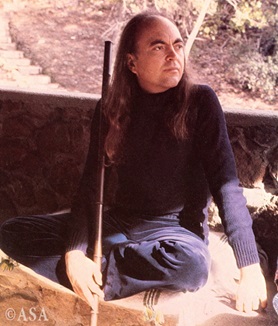
Adi Da Samraj [Da Free John] The Mountain of Attention, California, 1982
Adi Da reserved his personal company principally for his advanced practitioners, or those who sincerely responded to him as Siddha-Guru, and were then willing to engage in a living spiritual relationship by doing the sadhana required to be with him in Satsang as their Beloved Heart-Master. He was not going to make himself (and his transmission) available for casual onlookers and the interested or gawking public. Just like in ancient days, so they say, you had to climb a mountain, traverse great rivers, get past the lions at the gate, that is, overcome yourself—in other words, really work—to find your true Guru; so it was something like that, in my opinion. Thus, a person is required to travel to Fiji (or his other sanctuaries) in order to enter Adi Da's “kingdom” or “Pleasure Dome” (as he sometimes called it). A person who recognized him as an Adept-Realizer, as a rare being, feels graced to walk the ground that is (even today) saturated with His Divine Presence and Enlightened State. This isn't mere emotionalism but a connection to our Divine State. Go and find out if this is true, rather than complaining that it's inconvenient or not to your liking. Avatar Adi Da's Work, as mentioned, begins with his Teaching-Word but it's mostly about his Spiritual Heart-Transmission (Ruchira Shaktipat) that initiates the transformation of consciousness in a person's life as they respond from the heart and with an awakened mind [see Part 2]. This Satsang allows us to see Real God and Reality as It IS: Good, True, and Beautiful. This can only be appropriately done outside the public sphere, as it's been done for millennia. The advanced Yogis and Sages lived in the forests and mountains, not downtown (not that they couldn't, or didn't at times, but generally they did not). For example, even Jesus and Gautama, who sometimes did entertain large public crowds, always reserved their “secret” or esoteric teachings not for the general public but for their closest disciples (for these Adepts talked to the common masses in parables). A person must show some degree of maturity to make right use of an Enlightened Adept. This is why most people will first contact Adi Da Samraj through his books or video talks, and then apply through proper channels to visit retreat centers and his sacred sanctuaries, which are the agencies of his Spiritual Transmission and Divine Work for all to enjoy (and make proper use of). This is how one comes into “His Company” (or Divine Presence) today and in the future. It's as simple (and yet as difficult) as that! This is the way it's always been: Read the world's sacred scriptures and find out! 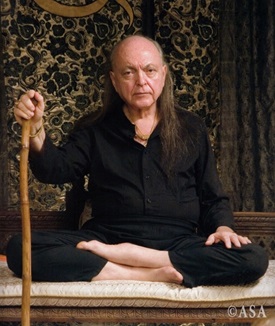
Adi Da Samraj Adi Da Samrajashram, Fiji, 2007
The Call for Real Spiritual Practice and RecognitionY es, wouldn't it be great if Master-Adepts could just go out and “save the world” and make life “perfect” for everyone, but, obviously, this is not how true esoteric spirituality works. Consequently, we must learn why and gauge our responses. We must realize that in Satsang and Guru Yoga we're engaging in an ego-transcending process, not one of ego-fulfillment. The Guru is not here to create Utopia (that's an egoic projection), but to show us how to surrender to God. A person needs to be an advanced practitioner—or at least a sincere one—before they are ushered into the inner temple. An ashram is not a downtown church; one is reserved for esoteric matters, the other for exoteric functions, respectively. People must be prepared to correctly receive the highest esoteric teachings and properly conduct the spiritual energy or transmission in their whole body-mind (and heart). This approach goes beyond singing hymns or listening to inspired sermons. It is a “reality-consideration.” For example, it's best if a person already knows how to meditate, for otherwise a Spiritual Master is only teaching the preliminary disciplines and practices. This is what Adi Da did during his earlier “Teaching-Submission” years (now recorded in his books for all to see and study). A person must learn, for example, to sit still, quiet the mind, open the heart, breathe the Holy Spirit—no simple task—before the Avatar is available (and accessed) rightly. This fact cannot be overlooked or undervalued; most public people, therefore, are not ready for advanced instruction although all are invited (and Called). Guru Yoga is a voluntary process of submission to Real God. Yet, even the inner circle of devotees can still fall short of being able to transform their egoic habit patterns and consciousness completely, since true Enlightenment is a very rare condition (as history proves). Adi Da's life, and the life of all genuine Adept-Realizers, is a play (in Sanskrit, a leela) to be honored, recorded, praised, and used for our spiritual development. Hearing stories and tales of Enlightened Adepts from around the globe, in every culture and century, acting in ways that might surprise or shock us, is the way to go beyond ourselves, to transcend our self-inflicted wounds and horrific wars, including the complacency of conventional living, in order to see a brighter vision and life for everyone in the world-Kosmos.[23] Adi Da Stands Free for all who can use him to their fullest potential: revealing your very Divine Condition to you (and to all-and-All). Adi Da Samraj was (and is) not “hiding” from anyone, as Wilber wrongly claims, for he's Calling everybody to come to see and be with Him, to come make right use of his Spiritual Heart-Transmission and Teaching (even now), to visit and make contact with his Agencies of Transmission. Then to live the active and sacred relationship of Satsang as he is still Calling us to do (and will forever hereafter)! He Calls people to listen (or study) his Teaching-Word—to hear him—or understand his teaching about Radical Understanding (addressing the contracted ego-I) and the state of our “always already” Divine Ignorance—and to see him (i.e., to recognize his sacred and holy function as Siddha-Guru)—and to feel his Divine Presence as Avatar where the Guru is recognized as the Agent of God. Only the heart will know for sure. But, truly, the heart does know (more than the mind). A certain level of maturity and intelligence, therefore, is needed, not the childish dependence of crass cultism or rebellious adolescence condemning the Guru-function. Respect and recognition is required before approaching the Avatar's holy institution (and ashram), before entering his sacred sanctuaries, the inner temple—“getting your shoes in order first” (as Adi Da puts it)—before coming into his direct spiritual company and sacred transmission field. The Siddha-Guru is not meant to be our psychologist and “therapist” rightening our ego through self-improvement techniques (though that will happen too), but allowing Him to be our Heart-Master, a Threshold-Personality to the Divine Brightness of Real God. This is neither a cult nor a game, but real religion.
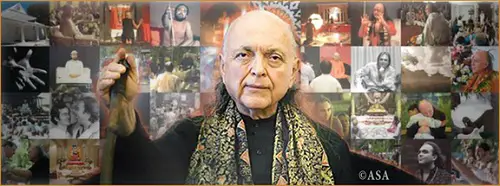 Parama-Sapta-Na Avatara Adi Da Love-Ananda Hridayam wants serious spiritual practitioners—people who have real intelligence, who have had a real heartfelt “recognition-response” to “Him” as the Divine Presence radiating through (and beyond) his incarnated human bodily form and existence—before becoming a devotee under sacred vow. As Adi Da would always say: “Come to Me when you're already happy.” Everyone at all times is always already invited, whether one becomes a devotee or is just a student of his Wisdom-Teaching. This process, therefore, is not about “hiding” but is about properly serving the esoteric and spiritual process that is activated and initiated in the Avatar's Divine Spiritual Company (even to this day and forever hereafter). Wilber, therefore, has done a disservice by confusing people with his misguided attitudes, for his misunderstanding and public outcry (on the Internet and in his recent books) have done damage to our sacred responsibility. I, for one, am attempting, in my own small way, to try and rectify this error. Everyone is invited to see and understand for themselves: God is already Free and always Here for all of us to realize, even now and now… and now (and forever now). And the God-Man Avatar Adi Da is here to serve everyone's Divine Awakening to this “always already” Enlightened State of God-Realization; nothing less! In any case, the authenticity of Adi Da's Sacred Company, his Enlightened Teaching, and his Spiritual Heart-Transmission, is absolutely real and fully authentic (multi-level-monist-charismatic) [see Parts 1-2], as any sincere person will discover if they give him their free and open-hearted attention. The negative tales arising out of samsara and maya will fall away into the Divine Conscious Light of Nirvana and Bright Love-Bliss. It is time we learn how to appropriately appreciate and rightly approach and honor Avatar Adi Da's Divine Gifts and to transcend our doubts and fears. Only then shall we discover and realize that Enlightened Love and Beauty is what is freely given by Adi Da—the “First” or “Primal” “Giver” (which is what “Adi” and “Da” mean, in Sanskrit, respectively). This fact becomes evident when you “Turn to Him,” for in truth, you are turning to your own Divine Condition and Enlightened State alive in and as your Heart chanting:
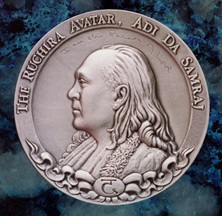
NOTES
Images of and quotations by Avatar Adi Da Samraj are copyrighted and managed by The Avataric Samrajya of Adidam Pty Ltd., a trustee for The Avataric Samrajya of Adidam (ASA).
All rights reserved.
Brad Reynolds' new book: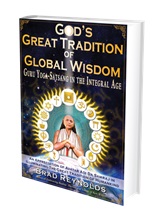 Guru Yoga-Satsang in the Integral Age — An Appreciation of Avatar Adi Da Samraj in Illuminating The Great Tradition of Humankind This book is NOW available on Amazon.com as a Color hardback or B&W paperback or eBook: See Brad's YouTube channel — GodsGreatTradition With an introductory video introduction by touring the Table Of Contents, please see: GODS GREAT TRADITION PROMO 2 This book defies many taboos. It unpacks the great tradition of spiritual transmission and the unique critical role of truly enlightened beings. And it advocates, in a full-throated and whole-hearted manner, for my Root-Guru, Adi Da Samraj, in a way that stands in that larger universal great tradition. We're all social creatures, who have internalized these taboos, so some readers may have reactions, and it may be necessary to persist despite them. But if you do, with an open mind and heart, this book will help you to recognize something profoundly important. "A Tour de Force" is the best way to describe the great work that Brad Reynolds has done with God's Great Tradition of Global Wisdom. It reminds me of the great classic The Passion of the Western Mind by Richard Tarnas, but Reynolds' opus is more thorough, deeper, and more inclusive. Of course, much of this depth and penetrating wisdom is achieved by drawing heavily on the Teachings he elucidates and illustrates, especially the Sage-Wisdom of Avatar Adi Da. Not only will the reader find a high-class education of a host of traditions, they will be treated to a panoply of fabulous, easy-to-grasp illustrations and images. A MUST for any student of the Great Tradition of humankind's spiritual inheritance.
|